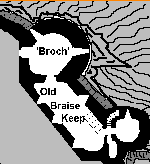The town of Lepidopter was a fishing village as early as the Stone Age (appx. 3000 BC in these parts). As the only reasonably secure harbor on the north shore of Almondsey in the North Atlantic, it was the base of the barons of that area, who at times proclaimed themselves King -- under onerous taxes from the Overlord of the Island, and because the northern Almondese always considered themselves a people apart anyway. Braise was the only one who met with any great success, and actually managed to
maintain independence for nearly 60 years, having led the revolution at the age of twenty-five and ruling
his kingdom until his death in his late 80's. There were no heirs, unfortunately (actually there were too many, but the legitimacy of each claimant was in dispute, and none had the charisma or intelligence of
his father); the kingdom fell to the Almondese Overlord within 12 years of Braise's death.
Nestled under the Citadel, the town was surrounded by a ditched embankment topped by a dry stone
wall (possibly once backed up by a wooden stockade). The River Elf, which is crossed by a bridge at the
'suburban' village of Sallow, cuts off the Gorgon Ness and a long hilly peninsula from the rest of
mainland Almondsey (which peninsula was the hinterland of the town, supplying all its cattle and grain). To
the north is a low headland (Opetcek) with a road leading to the barren north shore of Almondsey with its abundance of sheep. There was a small fort on the little island at the confluence of the River Elf and Trout's Beck, which is actually a 20-mile-long unnavigable river. To the east of the town wall, a very thick
dry-stone structure along this side and on the south, is a large common or sheep pound, as befits the main trade of the town apart from fishing; the wall tower projecting into this compound is called the judges'
stand, because that is where the sheep fairs are observed and policed, and also the sheep-dog trials
and village football matches refereed.
There are four gatehouses into the town (simple square towers with an arch and a barred door), the main
entrance being by the harbor and leading to the Great South Road that connects with the rest of
Almondsey, Some visitors will be surprised to note that the town contains no churches or temples (except
for the temple of Thooloo the Benign in the citadel); this is probably because the oppressive priesthood of Cthulhu the Maleficent, which terrorized the area for so long before Braise put a stop to it, pretty much
made all the inhabitants atheists. The Almondese establishment doesn't like this, but they have had no
success in converting the Lepidopterenes. Scientologists and Mormons, however, maintain a small
presence in the town.
The harbor now services a small fishing fleet, as there is no major trade any more -- except Russian
bootleggers and the like. Brick warehouses line the docks, built of Middle-eastern bricks brought as
ballast by traders; they are very picturesque, being so red and foreign-looking against the gray granite
and green grass which are the primary colors of the town and environs. The Pharos, or lighthouse, is
contemporary with the Citadel. It was a squat round tower on top of which a bonfire would be ignited
at night.

